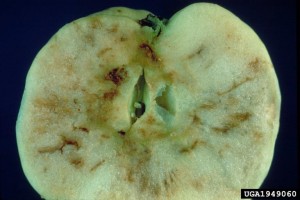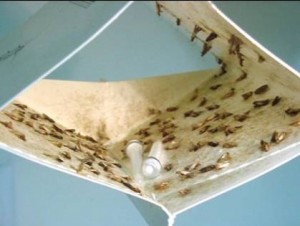Fruit Orchard Growers Find that Disrupting Apple Pest Mating Leads to Better Fruit
By Marcia Anderson
Taking a drive in the country, I pass numerous apple orchards, the trees in full bloom, with petals falling across my windshield, like giant snowflakes when a cool spring wind blows. I am reminded of a time, a generation ago, when people were spraying pesticides by the calendar in orchards and on farms throughout the country. For instance, they would spray for a certain pest before the trees’ buds broke in the spring, then every 7–10 days thereafter. The spraying occurred whether the pests were there or not because people were not scouting their crops to assess pest levels. Growers finally realized that pests don’t carry calendars and that their emergence varies from year to year. This validated the need for pest monitoring.
Today’s growers monitor certain pests with the aid of traps designed to include a chemical to attract only one certain pest. Such traps utilize chemical lures. The lures are synthetic copies of the chemicals (pheromones) the females emit to attract the males for mating. In apple orchards, traps, such as the one pictured here, are hung in the trees. The bottom of the trap is coated with an adhesive to capture the male insects. It is very effective control tactic for San Jose scale, codling moth, and oblique banded leafroller in lieu of pesticide applications.
With regular trap monitoring, growers know exactly how many moths are out in the orchard, which is the pest pressure, which in turn, helps them to determine if and when further treatment is necessary. When a moth is caught, growers know that first generation (the overwintering generation) has flown. Then, they can calculate degree days for the first generation eggs to hatch. At that point growers make a decisions for action. Northeast apple orchard growers discuss implementing pest-specific pheromone control strategies in their second video.

Apple maggot damage to an apple
(Photo: E.H. Glass, New York State Agricultural Experiment Station, Bugwood.org)
An effective use of pheromones is in conjunction with a small dose of pesticides. This is an extremely effective and low cost cultural control to disrupt insect mating of apple maggots. The apple maggot is a small fly that lays its eggs in a fruit. The maggots hatch and eat the fruit. Sometimes you do not see them until you bite into the fruit finding half a worm. UGH. Pheromone traps can trap apple maggot flies. A red plastic ball with an apple odor in the center resembles an apple hung on a tree and will visually and chemically attract the apple maggot fly. Orchard growers also use an organic insecticide on top of the fake apple. When an apple maggot lands on it, it licks the insecticide, which will cause the females to cease laying eggs and they will eventually die. In this way, the rate of insecticide needed is drastically reduced. A grower’s last resort is the application of chemicals.
Apple growers have now found the most effective way to control their pests is by using scientifically-based practices like Integrated Pest Management, or IPM, that have positive long-term effects on their orchard. IPM is an effective and environmentally sensitive approach to pest management that relies on a combination of common sense practices. IPM programs in apple orchards use current comprehensive information on the life cycles of pests and their interaction with the environment. This information, in combination with available pest control methods is used to manage pest damage by the most economical means, and with the least possible hazard to people, property and the environment. IPM takes advantage of all pest management options including inspection and monitoring for apple pests, the sanitation and maintenance of the orchard and trees, cultural practices like traps, and the judicious use of less risky pesticides, such as pheromone traps, first. IPM dictates that sprays are used only when needed for effective and long term control.
With IPM, you have to get to a certain pest population level, or threshold, before treatment is recommended. So, determining how to deal with pests based on thresholds is a primary step. How many of a certain kind of pest do you have? The threshold depends on the specific insect, weed, or disease.
There are a few challenges to IPM, not only in apple orchards, but with regard to controlling any pests. It is very important to rotate the modes of action of the chemicals that are used. Because with any pest population, if you use the same mode of action repeatedly, there are always a few pests that survive, creating future generations of pests who have developed pesticide resistance. The end result of resistance is that the overused pesticides lose their efficacy for pest control.
For more on apple IPM read: Apples for the Big Apple…Managing Pests to Produce Quality Apples. So the next time you eat an apple, think about your local apple growers and how they are using IPM to provide you with quality produce at reasonable prices.
About the Author: Marcia is with EPA’s Center of Expertise for School IPM in Dallas, Texas. She holds a PhD in Environmental Management from Montclair State University along with degrees in Biology, Environmental Design, Landscape Architecture, and Instruction and Curriculum. Marcia was formerly with the EPA Region 2 Pesticides Program and has been a professor of Earth and Environmental Studies, Geology, and Oceanography at several universities.


